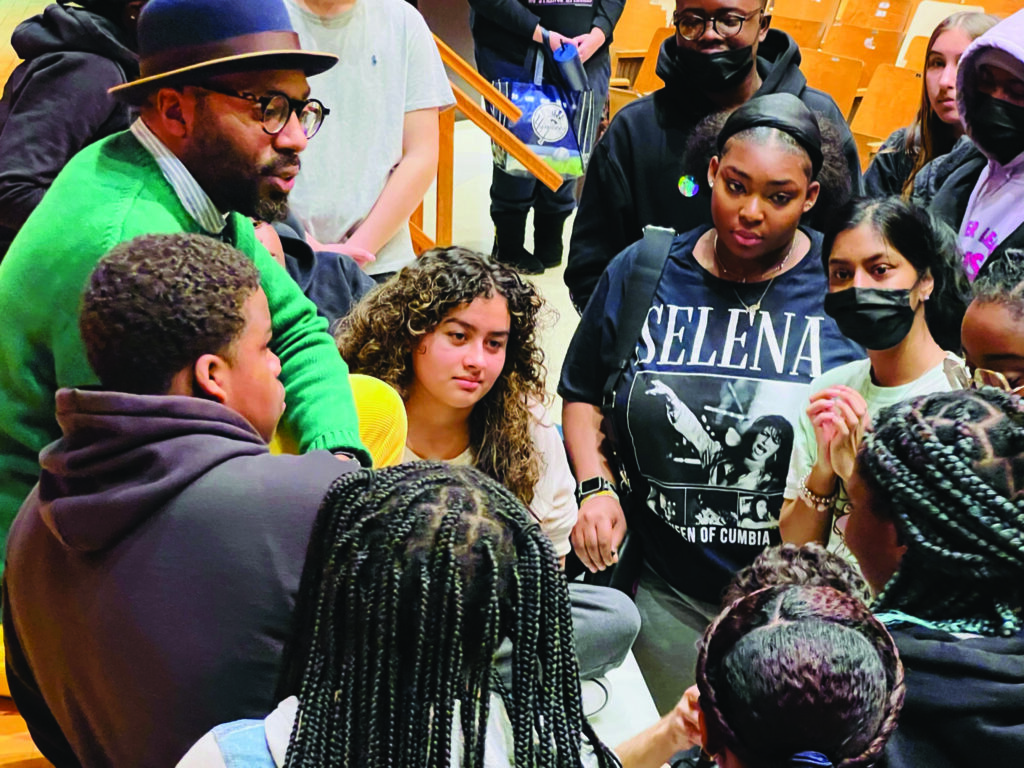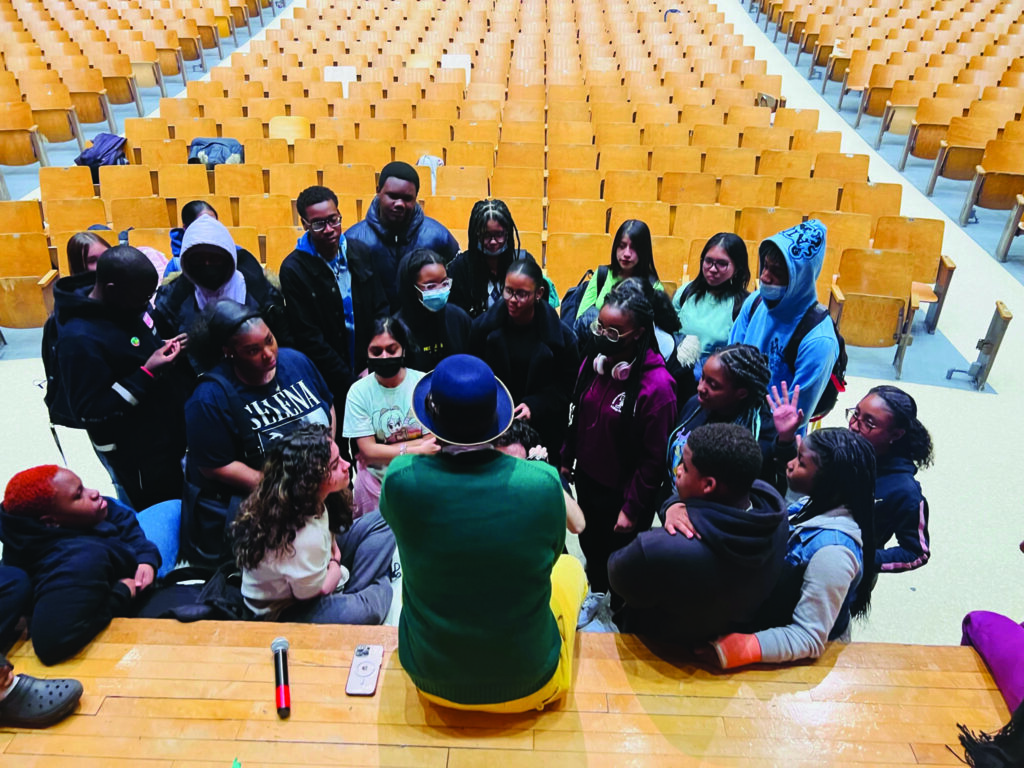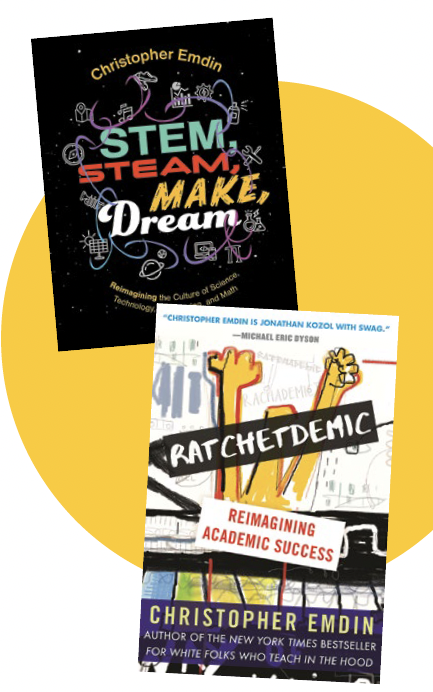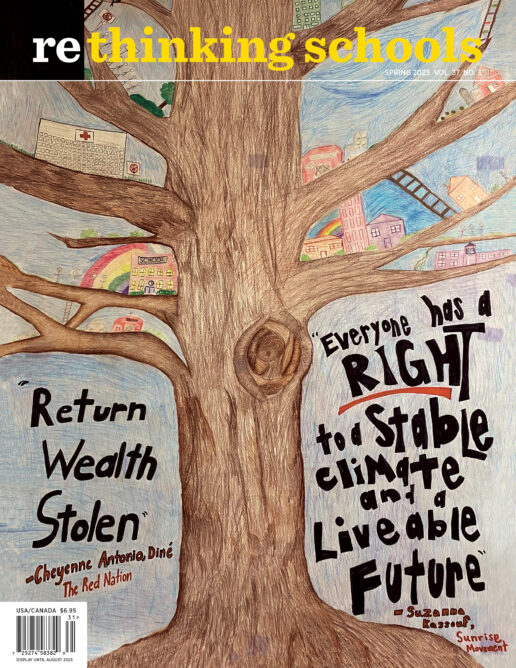Designing for Justice in and Beyond the STEM Classroom
An Interview with Chris Emdin

Christopher Emdin is the Robert A. Naslund Endowed Chair in Curriculum and Teaching at the University of Southern California. He partnered with the rapper GZA and the website Rap Genius to develop the Science Genius B.A.T.T.L.E.S., which engage students in science through the creation of raps and a final rap battle. Recent books include Ratchetdemic: Reimagining Academic Success; STEM, STEAM, Make, Dream: Reimagining the Culture of Science, Technology, Engineering, and Mathematics; and For White Folks Who Teach in the Hood . . . and the Rest of Y’all Too: Reality Pedagogy and Urban Education. Ayva Thomas, Northshore School District’s director of Racial and Educational Justice, interviewed Emdin on June 30, 2022.
Reimagine Classroom Spaces
Ayva Thomas: I know you’ve done brilliant work on designing classrooms. I’d like to hear your thoughts and experiences aestheticizing spaces for educational justice.
Christopher Emdin: There are a couple of theories that undergird and are central to my work. Two of those are: Teaching is a performance art, and young people are works of art. When you believe that teaching is a performance art and young folks are works of art, then the classroom is the stage, it’s the environment. It’s not just the teacher’s stage; it’s the shared stage that the teacher and the student dance upon in this beautiful back and forth that is teaching and learning.
And how can you think of teaching as a performance art and young folks as works of art, and not recognize that aesthetics are essential to that work? I often say, You ain’t always gotta tell somebody how you feel about them; you show them. One of the ways that we can show young folks that we care about them is by allowing them to learn in beautiful spaces.
As an educator, your body teaches, your voice teaches, what you wear teaches, and your environment teaches, because they communicate ideas and thoughts and values to people. I think that’s an understated dimension of teaching and learning. I’m well aware of what places that have not been aestheticized to celebrate young people do to them. I’m aware that classrooms with bars and windows incarcerate the minds of young people. I’m aware that metal detectors make young people feel as though they are criminals. I’m aware of what a dirty environment does to young people’s feelings of worth.
When you throw students in that kind of school, that kind of classroom, and then say I love you, the students feel that tension — That love can’t be real. I’m a firm believer in aesthetic education in the tradition of Maxine Greene, and also in reimagining what classroom spaces can look like to show young folks that they have value.
AT What creative energy do you pour into that design process? Who do you bring with you?
CE When I’m designing, I bring students with me all the time, and sometimes I can even see their faces. I can see a child I taught in 9th grade in 2013, and I’m like, That child would need this.
I’m always bringing my momma with me. My mom is Jamaican American and my grandmother was a domestic for the British who came to Jamaica. She was from Trench Town, but she would go to these posh British spaces, so she was a person who knew how to bring both worlds together in her home.
I also bring my ancestors. I love African art and the vividness of the colors of the African and Afro-Caribbean experience. African art is focused on boldness and brightness, and so I bring those elements.
As folks of color, our aesthetic traditions are oftentimes demeaned in places that celebrate the arts. There’s a perception that our art is lowbrow and low value. In my home, I merge what is perceived to be localized art with what is perceived to be highbrow art, and I hold them in the same esteem. I think classrooms should do the same. So part of my work in designing classrooms is creating spaces that center the voices and the aesthetic representations of marginalized folks and that allow them to see the beauty in themselves.

Foster Conditions to Thrive
AT In your book Ratchetdemic: Reimagining Academic Success, you define ratchetdemic, and I’m paraphrasing here, as a deep consciousness of the ways that people acquire important knowledge systems, and stay true to who they are as they navigate the spaces they’re in. What conditions need to be cultivated in classrooms for students, and especially minoritized students, to fully embrace their ratchetdemic selves?
CE Here’s the thing: Schools have subjects — English, math, social studies. But the most essential subjects for young folks are those that speak to them as subjects: You are the subject. We need more classes that help young folks study themselves.
In Ratchetdemic, I talk about different knowledges. I start with knowledge of self: who you are, whose you are, where your people came from, the beautiful stories, the stories of struggle, all the majestic things that got you to where you are. Young folks need opportunities in school to have those interrogations of self, to see value in self.
Then, you need knowledge of the environments in which you’re embedded. What circumstances and people got you to your neighborhood? Why is that neighborhood the way it is? If it’s an affluent neighborhood, why is that? Or why is it not affluent? Why do I only see white folks in this neighborhood? Why do I see no Black folks here but I see all Black folks there? Why do I see liquor stores here? Why do I only see strip malls here? Why are my surroundings beautiful when others aren’t? All young folk need opportunities to reflect on the environments they’re embedded in and ask the “whys” about where they are.
And then you need academic knowledge. That’s a knowledge of the subjects, the content. And if schools are only giving you one out of those three, they’re not giving you an education. If young folks don’t get all three knowledges, they’re receiving a substandard education.
And in each of those arenas, we don’t lower academic expectations; these are deep rigorous interrogations into those three forms of knowledges. If young folks get that in school, ratchetdemic naturally emerges, because they see value in who they are and where they come from, and then they are able to learn about things that are beyond them. Ratchetdemic is named and framed as an approach to allow us to give value to pieces of who young folks are that are erased from school, with the recognition that when those assets of self are present in schools, students do better at academic content.
If somebody introduces me to a mathematical concept that seems challenging, and I know that I have mathematicians in my history and my ancestry, because I know that I have mathematics in me, I put in the effort to learn that math. But if you just give me that math on its own, I’m like, I don’t know this. This is hard. I don’t give myself to overcoming academic obstacles if there’s no motivation.
Reimagine STEM
AT What inspired you to write STEM, STEAM, Make, Dream: Reimagining the Culture of Science, Technology, Engineering, and Mathematics?
CE When I was in school, I never saw myself as a scientist or a mathematician. I never felt like I was smart enough to do well in STEM. It was always for “the best and brightest kids,” “the chosen and special ones,” and I never felt like I was one of them.
People said, Chris, you mad funny. Yo, Chris, you can rap. Yo, Chris, you can dance. They never said, Chris, you’re a scientist. I’ve come to realize in my adulthood that I was using scientific and mathematical skills to be excellent at things that were not science and math. I was writing 16 bars and working in recording studios and knowing the intricacies of my body as I danced, and I didn’t know that was STEM.
I got lucky by having an amazing professor in undergrad [Dr. Liesl Jones] who saw me as a scientist, and once she saw that, the lights went on. But many young people don’t have that luck. So I wrote STEM, STEAM, Make, Dream for myself as a child.
It is geared, though, to teachers. And not just for science or technology or math teachers. This book is for all teachers to understand that if we’re truly interested in equity and justice, these are the subject areas in which we need to be most intentional about ensuring the success of children of color and others who have been marginalized.
You can’t just be like, I’m about social justice — write an English paper. That’s great, but if you really want justice, you want all children — LGBTQIA children, Black children, Brown children — to feel as though they can do well in all subjects, including STEM.
A lot of teachers in the humanities and in the social sciences have an awful relationship with STEM because they were broken by STEM as children. I redefine STEM not just for young folks, but for adults. I can’t do math; it’s just not my thing. Oh, science? I just can’t. These are folks who’ve been traumatized and I wrote STEM, STEAM, Make, Dream to help them heal.
AT Can you explain the title: STEM, STEAM, Make, Dream?
CE I’ve been a STEM teacher my whole career; I taught middle school math and science, I taught high school physics and chemistry. And then, I believe the arts are everywhere. That’s where the A comes in STEAM. I don’t want folks to think that STEAM is a new invention so we could put the arts in STEM. No, STEAM has always been there. We’re naming it so that we are intentional and deliberate about letting you know that the arts are the anchor of this thing.
I believe in making and doing, and I believe that dreaming is a verb; that’s why I call it STEM, STEAM, Make, Dream. I want to get us on a trajectory. STEM is the subjects. It’s always had art, but if you need me to say it out loud, it’s also the thing called STEAM. But guess what? STEAM ain’t even that poppin’ cause we’re all making things, and anything that you make is actually bigger than even STEAM. If you’re throwing a pot, if you’re cooking a new dish, if you’re doing an experiment, you’re creating something. That requires you to be able to dream about what you want to do. So, to me, it’s about making and dreaming more than anything else.
Embed Justice
AT There’s a misconception that it’s easier to embed educational justice pedagogies and content into ELA and social studies classes. Can you help debunk that myth?
CE I don’t think it’s hard to incorporate justice into STEM. It is not that challenging to have a curriculum that’s centered on the needs of young folks. One of my favorite activities with young people is to have them identify an issue in their community that they are viscerally dissatisfied with. Yo, Dr. E, I went to that park in my neighborhood and it was dirty. That’s jacked up. And then I was in a park in the rich neighborhood and it was mad clean. They’ll write that. I was upset and I was angry about how messed up our park was.
I’m like, That’s a phenomenal written piece. Now, I want you to find math facts to support your assertion. Your park was mad dirty? Word. How many pieces of garbage were there per square foot in that area? Calculate that. Your emotions are valid. Now use mathematical observations to support your arguments.
We begin with an emotional articulation through writing, and then I show them how, when you add science and math, no one can be unconvinced about your pain. So, math and science become tools for us to achieve justice.
All subjects need science-mindedness — the traits, the dispositions, and the attributes of scientists and mathematicians. Things like open-mindedness, skepticism, curiosity, being analytical, being anti-authoritarian; those are the core principles enacted by the most brilliant scientists. Evidence-based thinking — that’s the core of science. I can’t agree with that theory because there’s not enough evidence. Let’s conduct research to prove it. Social justice work. There is injustice in this community and we’re looking at folks who have been harmed as evidence to support those claims. It’s not a wide stretch. So yeah, that’s my stance on the ease with which we can engage in this type of work in STEM.
My vision for science is that young folks have it as a piece of their identity: I write, I dance, I’m a scientist, I’m a mathematician. I want it to pour out of young folks fluidly and with ease. I want them to lay claim to these disciplines and reimagine the ways that they see themselves through these disciplines. And I see science and math as tools for achieving justice.
Student Needs as Demands, Not Requests
AT I got to witness a workshop that you facilitated with high school students in March 2022 [at Northshore School District’s Student Justice Conference]. You had students reflect on their personal experiences in school and the demands they have for their education. It was powerful that you framed it as demands. Not I want this, but I demand this. Why should students be able to demand, instead of ask permission for, a justice-driven education?
CE We have spent so much time asking that our asks are simply background noise to those who wield power. They’ve turned our cries for a justice-focused education into just the static in their worlds, and no requirements for our sustenance ever get met. Because of that, it’s essential that we recognize that the things that we ask for are actually rights. That’s the framing. The last chapter of Ratchetdemic talks about the rights of the body: What are the rights that every human being deserves? Once you understand what those are, pleading turns into demands.
So, in the workshop with the young folks, my opening framing was Hey, I don’t know if you knew this, but there are rights that you deserve. You have a right to be here, you have a right to love and be loved, you have a right to feel, you have a right to your emotions. And once you open up to somebody what their rights are, it doesn’t take long for them to believe it — not at all.
But the issue is that they’ve never heard of their rights before. They know something’s missing.
When the demands come, they come with a little bit of pain. The moments when you were broken by the system get revealed, when you learned to function in your brokenness and act like you were OK. I still remember some of the things that I heard from the young folks: They never get my name right. That hurts. A young woman in that meeting said she learned to call herself by a mispronunciation of her name because they never got it right. Think about the depth of that. I said, You don’t deserve that because that person’s name gets said correctly. When you remind them of the pain that they’ve been able to overcome, they start realizing that they’re not going to be OK with being robbed of their agency anymore.
Zora Neale Hurston said: “If you’re silent about your pain, they’ll kill you and say you enjoyed it.” We have to teach young people to understand that it’s not OK to be silent about their pain. Folks aren’t doing you favors, there are rights that you should have, and once you know your rights, then you demand them.
Activate Dream Culture in the Classroom
AT Returning to the elements of STEM, STEAM, Make, Dream, how have you activated dream culture in your classrooms?
CE That brings us full circle to the beginning of our discussion about classroom design. I ask young folks, If you could have school the way that you’d like, what would you want? If you could change this classroom into what would be best for you, what would that be? Yo, fam, I’m asking you to dream of whatever you want. They’re like, I don’t know. They’ll fight me. Because we’ve colonized the imagination of our children. We’ve robbed them of the power of radical dreaming. The structures of how schools operate are so omnipresent, they don’t even know how to step out of that model.
So, for me, it’s being persistent in asking young folks to dream. And when they have a spark of something that’s beyond the norm, I feed it, fan the flame of the imagination.
I ask, How would you design this classroom differently?
I don’t know, we just have the seats and the desks.
Word. Wouldn’t you like it to feel a little bit like outside?
Yeah, I’d like it to feel like outside.
How can we make outside be in here?
What if we had no walls?
OK, there we go!
What if we had a whole glass wall?
It’s OK to dream of things that don’t yet exist. It is in the activation of the imagination that emancipation comes. The enslaved never had the conditions to allow them to know what freedom was. It was radical dreaming. It was like, We’re up here in these quarters, but I can dream of one day maybe being able to . . .
It’s when you take the blinders off the conditions of the norm that folks can see the beauty of the world around them. All the best inventions in the world came from somebody dreaming. Velcro was invented by somebody who was playing in the wild and got these little thistles stuck to their clothes and dreamed that, one day, maybe that could be the fastening on a sneaker. You can’t get to scientific innovation without the activation of the imagination. It’s impossible.
AT Dreaming activates a transcendence of time, too. You’re able to honor your ancestors and pull forth their ideas, visions, and dreams, and actualize that today for a more just tomorrow.
CE Time is erased when the imagination is activated. You can go 500 years in the past or 500 years in the future. The class is the launching pad for the learning to happen if you allow the kids to dream. They come there for 40 minutes and you open up the imagination, and then they leave you and they dream for the rest of their lives. I love what you said. Transcending space and time should be a daily enterprise.
Christopher Emdin is the Robert A. Naslund Endowed Chair in Curriculum and Teaching and Professor of Education at the University of Southern California, where he also serves as director of youth engagement and community partnerships at the USC Race and Equity Center. He previously served as director of the Science Education program at Teachers College, Columbia University and alumni fellow at the Hiphop Archive and Hutchins Center at Harvard University. The creator of the #HipHopEd social media movement and Science Genius B.A.T.T.L.E.S., he is the author of STEM, STEAM, Make, Dream (Houghton Mifflin Harcourt), Ratchetdemic (Beacon Press), and For White Folks Who Teach in the Hood . . . and the Rest of Y’all Too (Beacon Press).


